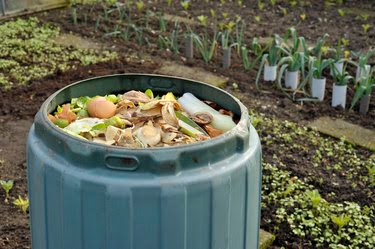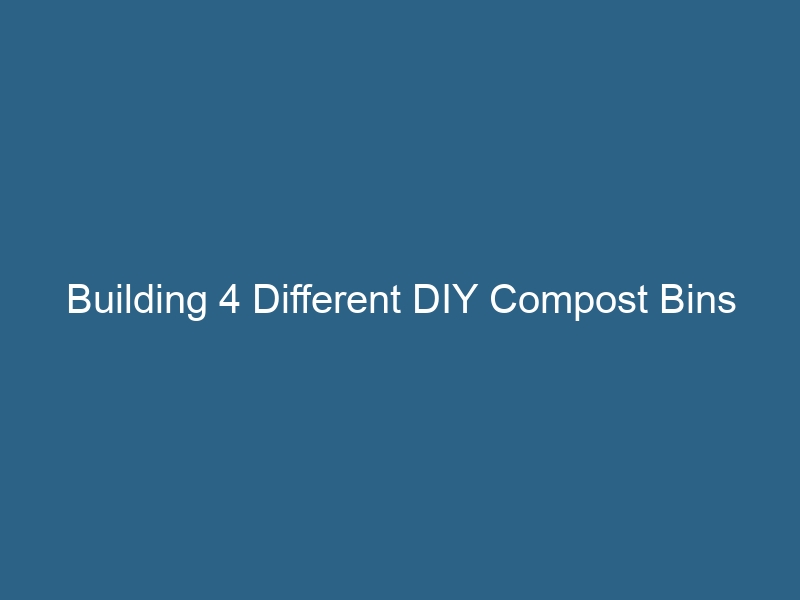Quck answer
There are four different types of DIY compost bins that you can easily build at home:
1. Wooden Pallet Bin: Use wooden pallets to create a simple and affordable compost bin. Just attach the pallets together to form a box-like structure.
2. Wire Mesh Bin: Construct a compost bin using wire mesh fencing. Bend the mesh into a circular shape and secure it with wire or zip ties.
3. Plastic Bin with Hinged Lid: Repurpose a large plastic container with a hinged lid to create a convenient compost bin. Drill holes for aeration and drainage.
4. Tumbling Bin: Build a rotating compost bin using a plastic barrel or drum. Add a handle and axle for easy turning.
Choose the DIY compost bin that suits your needs and start composting your organic waste at home.
Anyone who has a garden, regardless of its size, should have a compost bin. This allows you to convert yard waste and food scraps into organic material that can be used to enrich the garden soil. While you can simply pile compost in a corner of your yard, the issue with this approach is that the best compost is located in the middle of the pile, making it difficult to access. A compost bin solves this problem by providing a way to turn the pile, ensuring that all the compost is accessible. Additionally, turning the compost helps with uniform heating and decomposition.
When it comes to DIY compost bins, there are numerous ideas available, and most can be implemented with minimal effort and cost. Some designs involve using lumber, while others suggest using barrels, which can be substituted with recycled plastic drums or old plastic trash cans. If you don’t have access to these materials or are on a budget, you can even create a basic compost bin using a cardboard box.
Qualities of a Good Compost Bin
Compost is essentially decomposed organic matter, and the raw materials can include grass clippings, dry leaves, and kitchen scraps (excluding animal products, although eggshells can be included as they add calcium to the compost). Various critters, such as earthworms and centipedes, consume the organic matter and aid in the composting process. Microbes like bacteria and fungi also play a role by feeding on the compost and further breaking it down into the soil. To ensure efficient decomposition, good airflow is necessary. Therefore, a good compost bin should have open sides or plenty of holes for aeration.
Finished compost is a loose and crumbly material that is rich in organic matter. Its main purpose is not necessarily to act as a fertilizer, but rather to improve the quality of the soil by loosening clay and fortifying sand with loamy material. To achieve this consistency, the compost needs to be turned periodically to evenly distribute the heat generated during the composting process and to prevent clumping of the raw materials. You can design a bin that allows you to do this manually using a pitchfork, or you can opt for a rotating drum design that turns the compost with each rotation of the drum.
A good compost bin should provide an easy way to add compost, extract finished compost, and monitor the moisture level of the mixture. The ideal compost mixture consists of a balance between carbon and nitrogen, roughly in a 50:50 ratio. If there is an excess of nitrogen (which is obtained from green materials like grass clippings), the mixture can become a smelly sludge. On the other hand, if there is too much carbon (from brown materials like woody stems, cardboard, and leaves), the decomposition process will proceed very slowly.
1. Building a Wood and Wire Compost Bin
A wood and wire compost bin is a step up from an open compost pile. Its advantage is that it consists of three compartments, allowing you to “turn” the compost by transferring it between bins. One compartment is used for adding raw organic materials, another for removing finished compost, and the middle compartment is where the composting process takes place. You can construct this three-compartment composter using old wood from your yard or pallets. However, it is advisable to avoid using pressure-treated wood, as it can contaminate the compost and, consequently, your garden.
- To create four identical rectangular panel frames, use 2×4 lumber. Attach steel mesh, like chicken wire, to each frame by stapling it to the wood with fence staples. Two frames will be the outer sides of the bin and only require mesh on one side, while the other two will separate the middle compartment and should have mesh on both sides. If possible, use wood pallets of the same size for the frames. The pallet slats will hold the compost, eliminating the need for wire mesh.
- Construct three additional panels for the back in the same manner, with mesh on one side. These panels do not need to be the same size, but they must be the same height as the side panels. For the first compartment where all the raw compost is deposited, you may want to make the back panel larger than the other two to allow for more space.
- Join the back panels and side panels together using screws or nails to form a bin with three compartments. Strengthen the bin by attaching two pieces of 2×4 lumber long enough to span the length of the bin to the bottoms of the side panels, and two identical 2x4s to the tops of the side panels at the front and rear. Place the finished bin on level ground and fill the first compartment with composting materials.

Image Credit:
Grahamphoto23/iStock/GettyImages
2. How to Create a Basic Compost Tumbler
If you only add kitchen scraps or dense organic material like chicken manure to your compost, a single-compartment drum composter that can be rotated horizontally is more efficient than a bin or compost pile. To make a simple rotating drum composter, all you need is an old plastic garbage can with a tightly-fitting lid and a pair of bungee cords.
- Find an old trash can to convert into a compost drum. If you don’t have one, you can ask your neighbor or purchase one from a local building center. Make sure the trash can has a lid that fits tightly, preferably one that snaps shut.
- Using a 3/8-inch drill bit, create numerous holes in the sides and bottom of the trash can.
- Insert 3/8 x 6-inch bolts through some of the holes and secure them with nuts from the inside. These bolts will act as spines inside the drum, separating the compost as you rotate the drum and preventing clumps from forming.
- Remove the handles of the trash can by sawing them off with a hand saw or reciprocating saw. This will make it easier to turn the drum.
- Place a pair of bungee cords over the lid and insert the hooks through the holes you drilled to prevent the lid from coming off.
When it’s time to add material to the composter, unhook the bungee cords, remove the lid, add the compostable material, and then replace the lid and bungee cords. To turn the composter, lay the drum on its side on the ground and roll it back and forth with your foot. For proper composting, remember to turn the drum at least once a day.
3. Steps to Construct a Cardboard Box Composter
In Japan, where many people live in apartments without space for a traditional composter, composting in cardboard boxes has become popular. This method is similar to composting in a 5-gallon bucket, but you need to take precautions to prevent the cardboard from deteriorating. To do this, fill the box with dry materials and only add kitchen scraps in the middle of the box.
- Secure the seams of the cardboard box using duct tape, heavy-duty packing tape, or PVC tape on the sides and bottom. Place an additional sheet of cardboard at the bottom to prevent the compost from touching the box.
- Fill the box about 2/3 to 3/4 full with coco coir, peat moss, rice hulls, or a combination of these materials. Mix the contents well.
- Create a cavity in the center of the mixture for adding your food waste. Make sure there is at least 4 inches of material between the bottom of the cavity and the bottom of the box. After placing food waste in the cavity, cover it with topsoil. If you are using a 2-foot-square box, you can add approximately a pound of food scraps per day. In about three to four weeks, you will have plenty of nutrient-rich soil to use in your garden.
4. Steps to Build a Rotisserie-Style Compost Tumbler
A more advanced version of the rolling tumbler, made from an old trash can, involves suspending a plastic 55-gallon drum on an axle attached to a wooden frame. Use a barrel that is closed on both ends, such as one used for storing and transporting edible liquids like vegetable oil (avoid using barrels that stored fossil fuels or cleaning/painting solvents). By mounting the tumbler at an appropriate height, you can roll a wheelbarrow underneath it when it needs to be emptied. There are various designs for the frame, but one of the simplest options is to connect two identical triangular sides at the bottom using braces.
- To construct each side, take two 8-foot 2x4s and cut a 30-degree angle on one end of each. Then, screw the ends together to form a triangle with an open base. To stabilize the triangle and support the drum, attach a shorter length of 2×4 across both sides of the triangle about 3 feet from the top.
- To create a rectangular opening in the drum for a shovel, use a reciprocating saw. A good size for the opening is 14 inches long by 11 inches high. Attach hinges to the top of the opening before cutting out the rest of it. Attach a metal strip on the inside of the bottom of the opening to act as a door stop. Install a latch to keep the door securely closed while turning the drum.
- Create the axis by marking the center of each end of the drum. Drill a 1 1/4-inch hole at each mark. Insert a length of 1 1/4-inch PVC pipe through the holes, ensuring it extends 2 inches beyond each end. Feed a length of 3/4-inch galvanized steel pipe through the PVC pipe, making sure it extends about 6 inches beyond each end of the drum.
- Drill several 1/4- to 3/8-inch aeration holes in the drum. Optionally, insert 6-inch bolts into some of the holes and secure them with nuts on the inside of the drum to prevent clumping while turning the drum.
- Measure the length of the PVC pipe and cut two lengths of 2×4 lumber that are 6 inches longer. Use these to connect the two sides of the frame, positioning them about a foot off the ground. The 2x4s should overlap the edges of the triangle boards and the ends should be flush with the outsides of the triangles. This will ensure the cross-braces are the same length as the PVC pipe.
- Drill a 3/4-inch hole in the middle of each cross-brace. Align the ends of the PVC pipe with these holes and pass a 3/4-inch galvanized steel pipe through the cross-braces to support the drum. The steel pipe should extend about 2 1/2 inches beyond the frame on both sides. To secure the steel pipe in place, drill a 3/8-inch hole through each end, insert a nail, and bend the end of the nail using pliers.


